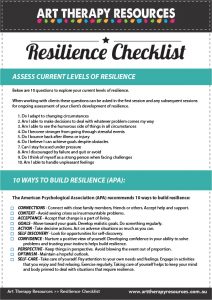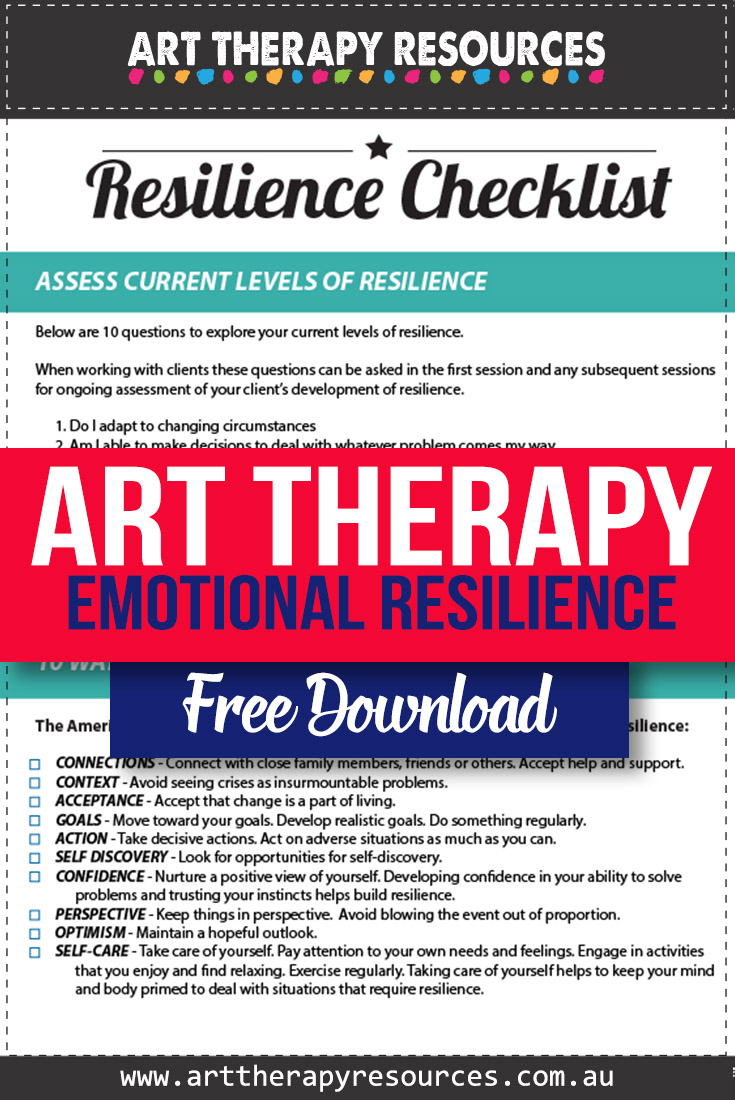THIS POST INCLUDES:
1. What is resilience
2. Art therapy can help build resilience
3. Processing Emotions
4. Resilience Checklist
5. Free Download Resilience Checklist
WHAT IS RESILIENCE
The below content is taken from the Developing Resilience Guidebook that is available to purchase in our store.
Resilience refers to the capacity we have to bounce back from difficult situations. Resilience is not ignoring or suppressing the emotional effects of difficult situations, but instead, it is the ability to process emotions and thoughts and resume normal functioning despite difficult situations.
To be resilient means facing everyday stress as well as singular trauma events. Trauma events can present as a distinct event, however, daily stress can develop and grow in intensity as we go about our daily lives. For some people, this stress can build for a short period of time before an emotional break occurs. For others, the accumulation of daily stress results in exhaustion and begins to change the fundamental beliefs a person has about their ability to cope with life.
Life is unavoidably difficult whether it be through traumatic events or daily stress. To protect our overall wellbeing it is important to learn skills that will help us become resilient.
PERSONAL CHARACTERISTICS
To be resilient does not mean an individual completely detaches from their negative experiences. Instead, all experiences help form part of the collection of personal characteristics that the individual develops.
Resilience is displayed through personal characteristics in the following areas:
- Social skills – the ability to communicate, extend empathy and compassion
- Problem-solving – developing insight, thinking skills, and the ability to apply a flexible approach to problems
- Autonomy – developing self-esteem, self-awareness, internal locus of control, and self-efficacy
- Sense of purpose – developing goals, motivation, interests, optimism, and meaning.
ART THERAPY CAN HELP BUILD RESILIENCE
Art therapy provides the below positive benefits:
- Self-expression
- Sense of autonomy
- Increased self-worth
- Increased self-esteem
All of these benefits are integral to developing resilience within a person to help face future adversity.
Art therapy involves three important components that help facilitate healing and growth:
- the creative process
- outcomes from the art making activity
- the therapeutic process of creating
Art therapy can enhance an individual’s resiliency by:
- Facilitating creativity – this can be a protective process by using imagination for reframing the traumatic event.
- Increased self-esteem – can boost mastery skills and the client’s belief in their ability to cope with adversity
- Individual support – facilitated by the art therapist and their relationship with their client
- Group support – clients can be part of a group that has experienced trauma together and then use art making as a source of creating social bonds
- Non-judgmental expression – the client can express without judgment in their artwork
One of the key aspects of resilience is acknowledging and building upon the strengths that the client has. By acknowledging these strengths, individuals learn they are capable of facing adversity.
PROCESSING EMOTIONS
Emotions are aroused due to many factors including direct experiences, memories, and witnessing experiences. How these emotions are regulated is integral to an individual returning to normal daily functioning from stressful situations.
Art therapy can play an integral role in facilitating the process of emotional regulation by providing an outlet for emotions as well as providing a place in which the individual can sort through emotional meaning before they evolve into emotional reactions.
Once emotional regulation has occurred the client can return to a feeling of safety where emotions and thoughts are stable. The client gains a sense of control over their internal conflicts.
Additionally, art therapy can help clients establish some distance from the overwhelming emotions and thoughts that persist. This occurs by using art to create metaphors and symbols that represent the traumatic experience or stressful situation.
Art therapy allows the client to externalize their internal conflicts and engage in the process of observing their feelings through art creation and self-reflection once the artwork has been created.
Creating art also allows clients to explore scenarios where they gain emotional distance from their traumatic experiences. Creativity enables the transformation of a person’s experience into something new using art making that can help reframe experiences.
Art therapy is inherently therapeutic through the process of being creative and providing the client with the opportunity to explore their emotions in a non-confrontational manner through art making.
The making of art itself is important as well as the ability to communicate and express emotions through the art making process.
Art making is not a prescription of following a specific recipe to achieve a specific outcome. Instead, art making encourages flexibility and the idea that the client can intuitively change their method in the middle of an art exercise so that their emotions and expressions remain a central focus.
Emotional regulation is an important part of resilience. Negative emotions need to be managed and positive emotions should be fostered. Emotional reactions are a natural part of life and with awareness, we can use our emotions to improve wellbeing. Being aware of our emotional reactions and managing them will help us not become overwhelmed by them in distressing situations.
Emotions help us learn and develop memories. Emotions can help us communicate, develop social awareness, and motivate us towards action. Emotions are essentially a combination of physical and cognitive reactions. Some examples of physical reactions from emotions include increasing our temperature, our body shaking with anger or laughter, and our breathing becoming fast or slow.
RESILIENCE CHECKLIST
Below are 10 questions to explore your current levels of resilience. When working with clients these questions can be asked in the first session and any subsequent sessions for ongoing assessment of your client’s development of resilience.
1. Do I adapt to changing circumstances
2. Am I able to make decisions to deal with whatever problem comes my way
3. Am I able to see the humorous side of things in all circumstances
4. Do I become stronger from going through stressful events
5. Do I bounce back after illness or injury
6. Do I believe I can achieve goals despite obstacles
7. Can I stay focused under pressure
8. Am I discouraged by failure and quit or avoid
9. Do I think of myself as a strong person when facing challenges
10. Am I able to handle unpleasant feelings
Further reading:
For more articles that relate to developing resilience, check out our previous blog posts listed below:
- 10 Art Therapy Exercises for Anxiety
- Case Study: Art Therapy for a Client with Emotional Overwhelm
- Case Study: Using Art Therapy for a Client with Anxiety (GAD)
- Case Study: Using Art Therapy for a Client with Identity Issues
- Challenging Negative Automatic Thoughts With Art Therapy
- Self-care for the Art Therapist
- Using Art Therapy For Your Own Self-Care
FREE DOWNLOAD: Resilience Checklist
SIGN UP below to download the FREE Resilience Checklist.

BUILD YOUR ART THERAPY REFERENCE MATERIALS:
Pin this image to your Pinterest board.

SHARE KNOWLEDGE & PASS IT ON:
If you’ve enjoyed this post, please share it on Facebook, Twitter, Pinterest. Thank you!
